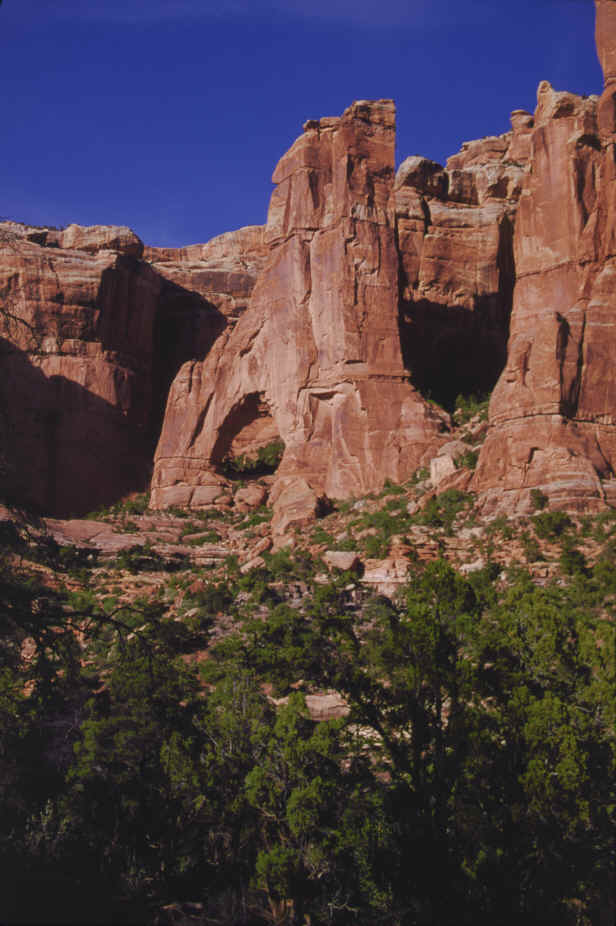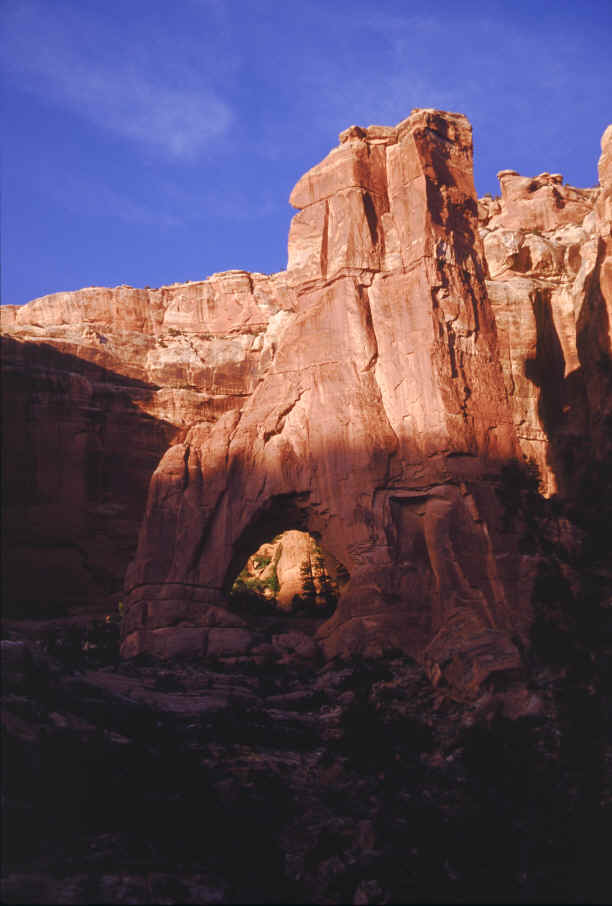

Several other areas of Utah are good areas for finding arches besides the Moab and Escalante areas. Bryce Canyon has several -- rather fragile because of the crumbly rock that the whole canyon is made of. And though Zion National Park, the most famous park in the state, is strangely lacking in arches, one of the few that it does has is one of the greatest in the world. Also the San Rafael Swell, right in the center of the state, has some good examples, and so does the beautiful Capitol Reef National Park. One of the most impressive areas of all is Natural Bridges National Monument, and the nearby Arch Canyon; but even those great spans are outdone by the greatest natural bridge on earth, the Rainbow Bridge, off by itself on the south shore of Lake Powell.
Kolob Arch --
Zion National Park, in the Kolob Canyons section.
Long thought to be the longest arch in the world, with
an opening of around 300 feet (as long as a football field), the massive Kolob
Arch is now usually considered to be only the second longest in the US, after the
Landscape Arch in Arches National Park. More accurate ways to measure
arches have been devised in recent years, such as with lasers, but measuring a
structure like this can be dangerous work; and still, the two arches are so
different, and it can be so difficult to tell exactly where an arch begins and
ends, there will always be fans of the Kolob Arch who insist that it is the
greatest one of all. And no doubt it will be eventually -- it is as
solid and massive as the Landscape is fragile and precarious. But only
dedicated hikers can ever see this grand span -- it requires a strenuous 14-mile
hike.
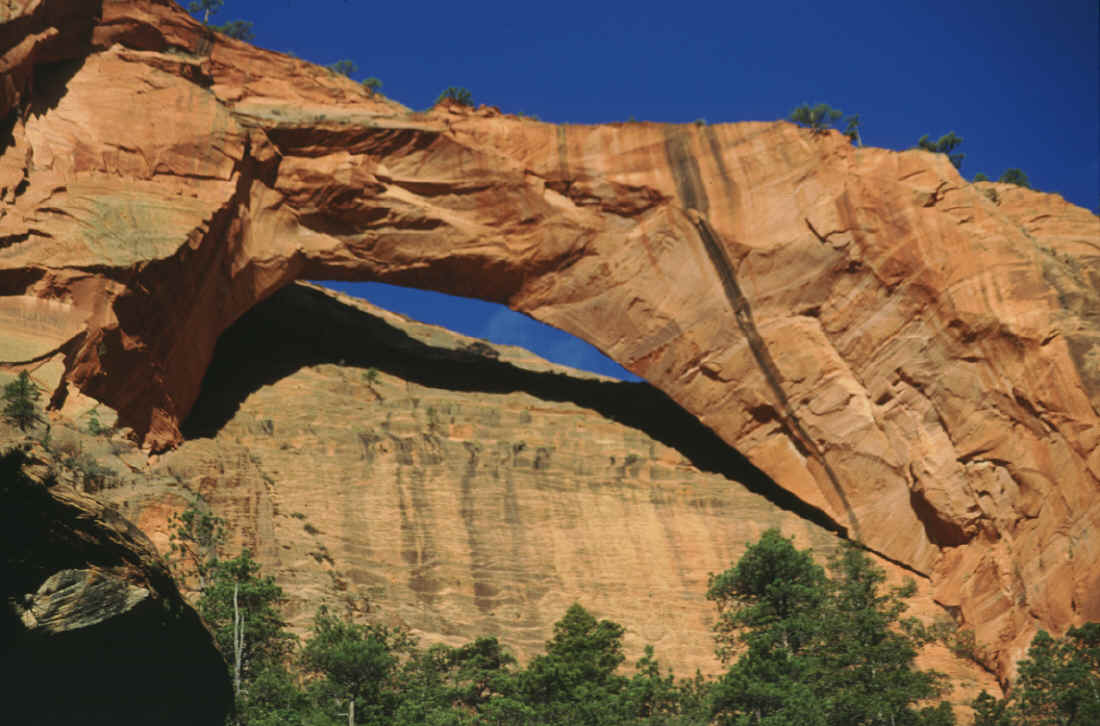
This little canyon in front of the Kolob
Arch really is as steep and V-shaped as it looks
here. It took me an hour just to find a spot flat enough for me to pitch
my tiny backpacker tent. But the morning light on the arch was
magnificent.

Hidden Arch
-- in Zion National Park.
Green leafy trees are an unusual sight near most western arches,
but this
little arch is so far above the valley floor that it has its
own micro-climate.
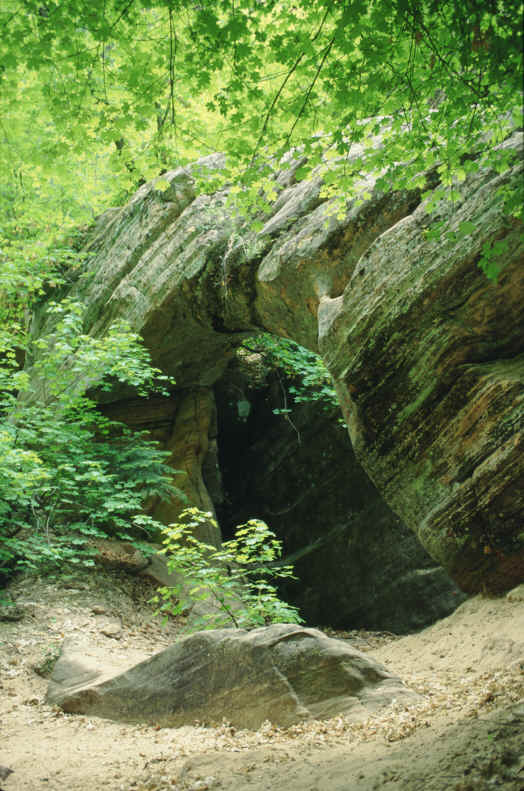
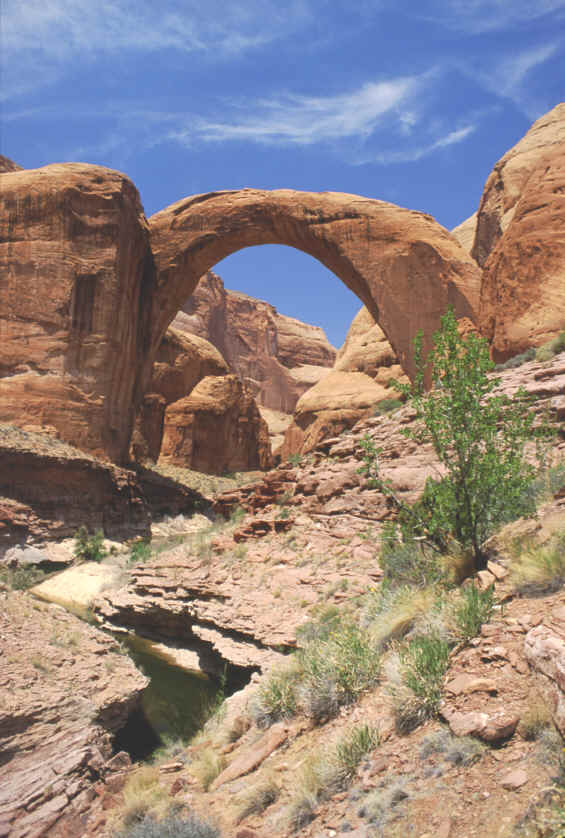
Rainbow Bridge -- the world's
largest natural bridge! 275 feet wide, 290 feet tall...
the United States Capitol is 289 feet, for comparison. It is a natural
bridge, not an arch,
because it was formed and carved by the stream below it. The level of the
stream many
thousands of years ago was much higher, nearly at the level of the underside of
the bridge.
The streambed cut lower and lower through the course of the many centuries,
carving out
the rock under the bridge, bit by bit.
This view is from the back side.
This is the front side, or the side you would see first, coming in from Lake
Powell.
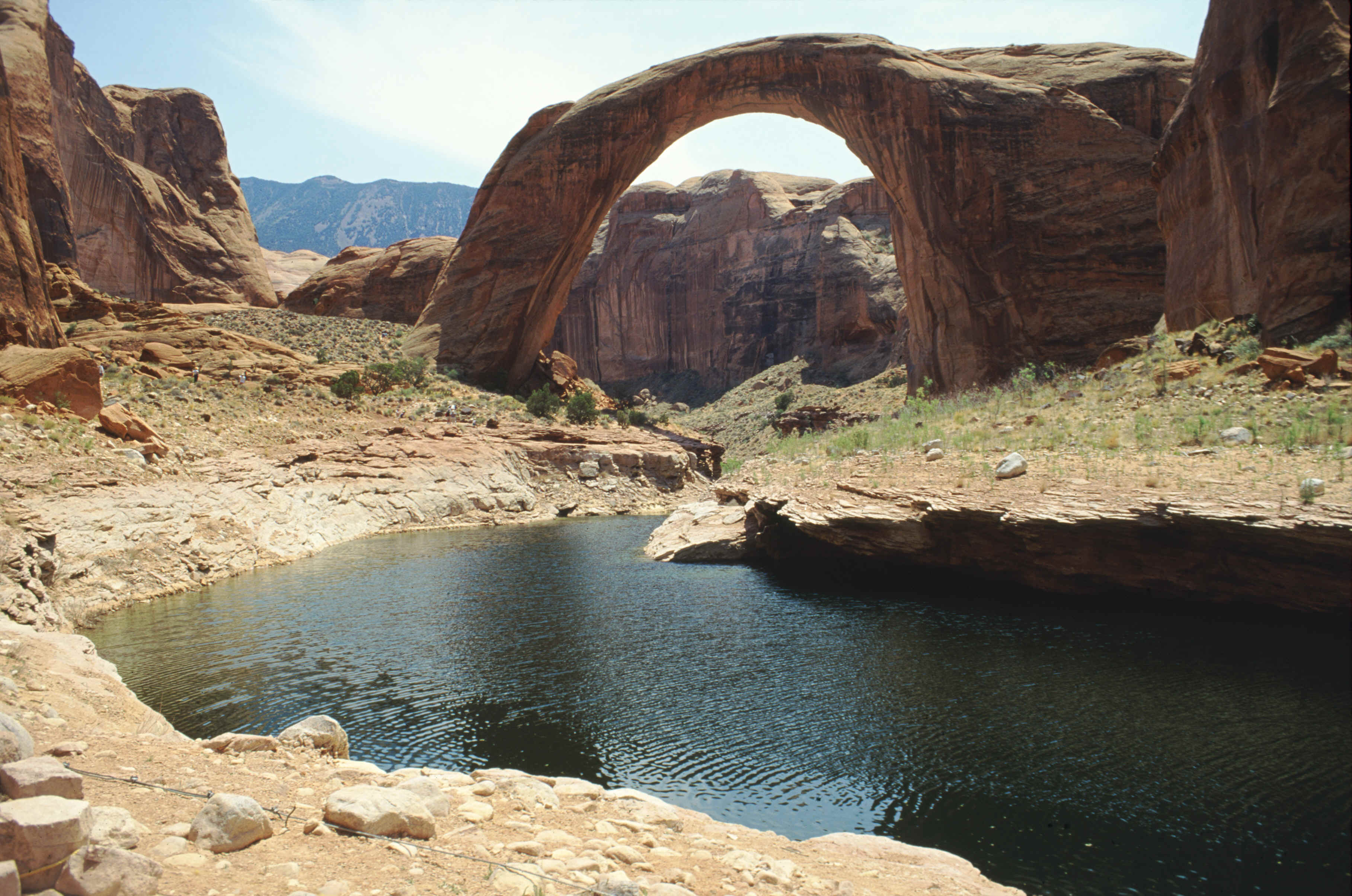
The world's second largest natural bridge is the
Sipapu Bridge, in Natural Bridges National
Monument. It is exactly how one would think a natural bridge should look
-- flat top, perfectly rounded opening, and a stream flowing underneath.
The canyon where it is located, White Canyon, has two other magnificent natural
bridges in it too, the Kachina Bridge and the Owachomo Bridge. All three
can be visited in a one-day hike along the stream.
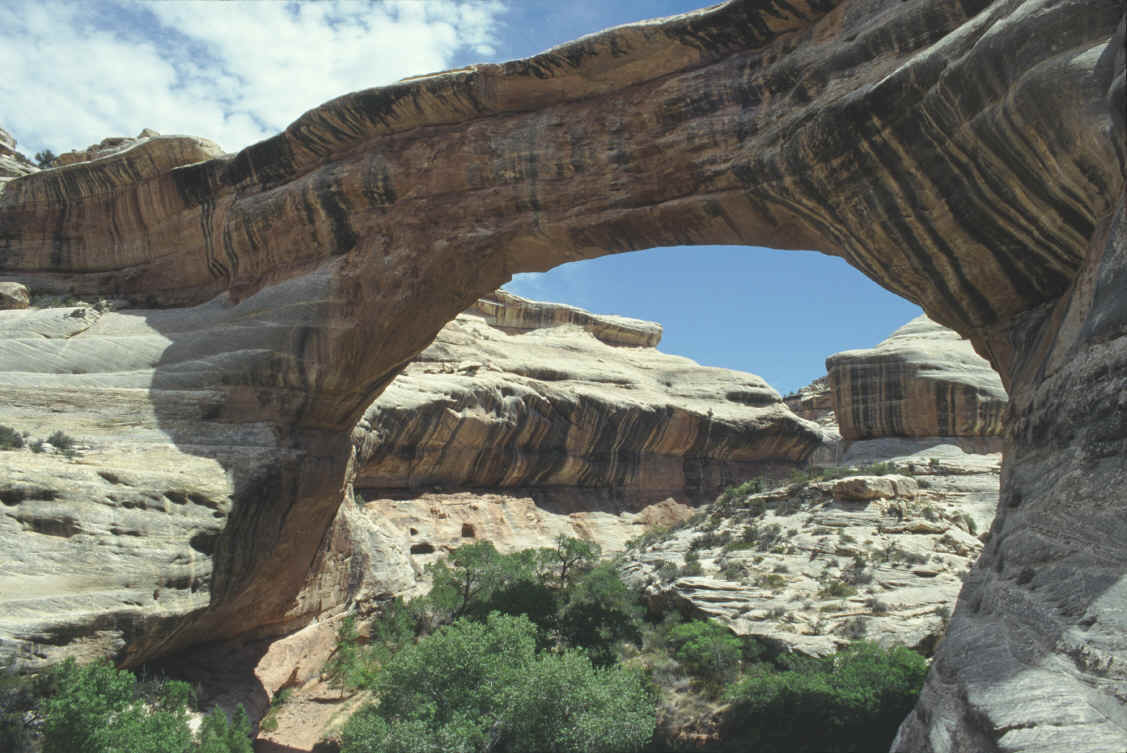
Peekaboo Arch -- Muley
Twist Canyon, Capitol Reef National Park
Two early morning shots in an odd pinkish-purple light. This arch is not huge, but
is uniquely shaped and is so prominently situated that it can be seen for many
miles away to visitors approaching on the Burr Trail through the southern
section of Capitol Reef. It can be easily driven to, though a decidedly
scary but spectacular series of switchbacks starts right beyond the arch.
Several more arches, including an impressive double, are found on up this small
canyon "so crooked it could twist a mule".


The Hickman Arch,
usually referred to mistakenly as a bridge, is the largest in Capitol Reef
National Park. It's just about a mile off the main park road, and makes a
pleasant hike there and back. It is still growing -- there is some rather
fresh rockfall visible on the left side with sharp, uneroded edges.

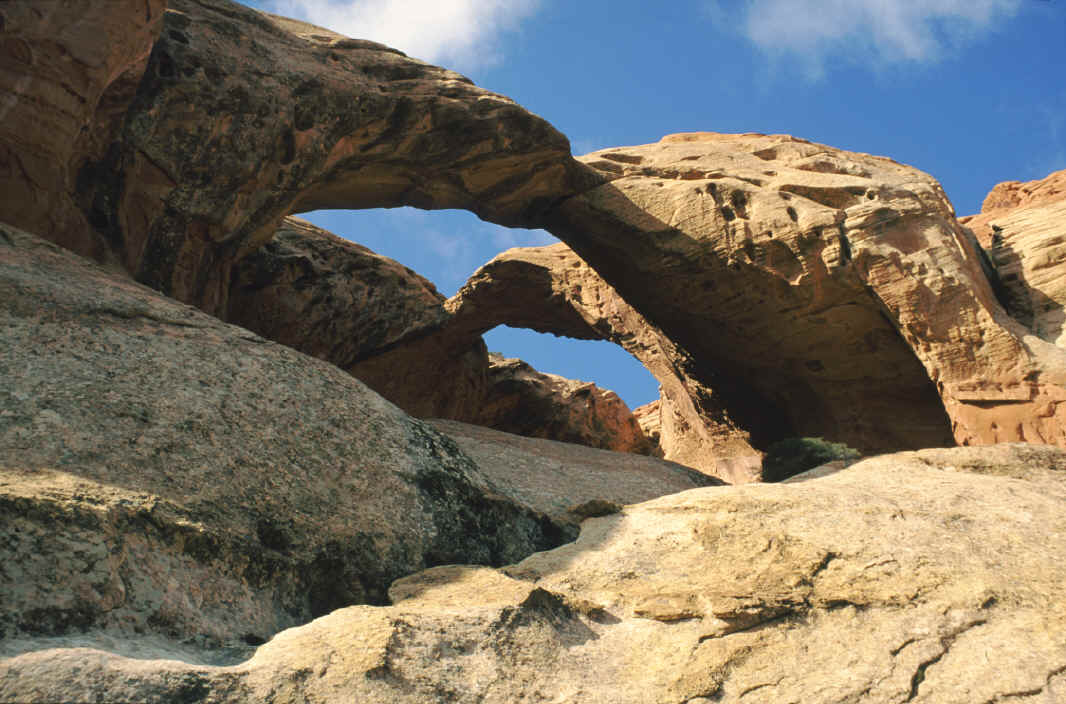
Muley Twist Double Arches --
the first time I ever hiked up the Muley Twist Canyon in Capitol Reef, I noticed
what looked like a large alcove ahead. I thought it might possibly be an
arch, but doubted it; alcoves are common and seldom very interesting.
But when I got up near it, was I ever surprised... not only was it an arch, it
was the best double arches I've seen outside of Arches park.
Spear Bridge
-- Capitol Reef National Park
It was a hard climb, and we didn't know where we were going, but we found
it! Some arch hunts can really turn into goose chases, but after a lot of
wandering around, we finally found what we were looking for, the pretty little
Spear Bridge, with its perfect bridge shape.

Tower Bridge --
Bryce Canyon National Park
This is one of the largest of the arches in Bryce Canyon -- the arches there
don't grow to great size because the rock is so crumbly, and they don't last
very long either,
at least compared to the more solid ones in other parts of the state. The
loose rock forming the slope in front of the arch is knows as scree, or talus...
greatly hated by
all hikers! For every two steps up, you are quite likely to slide 3 or 4
back, usually losing your balance too. If you ever make it up, coming back
down is quite easy, though.
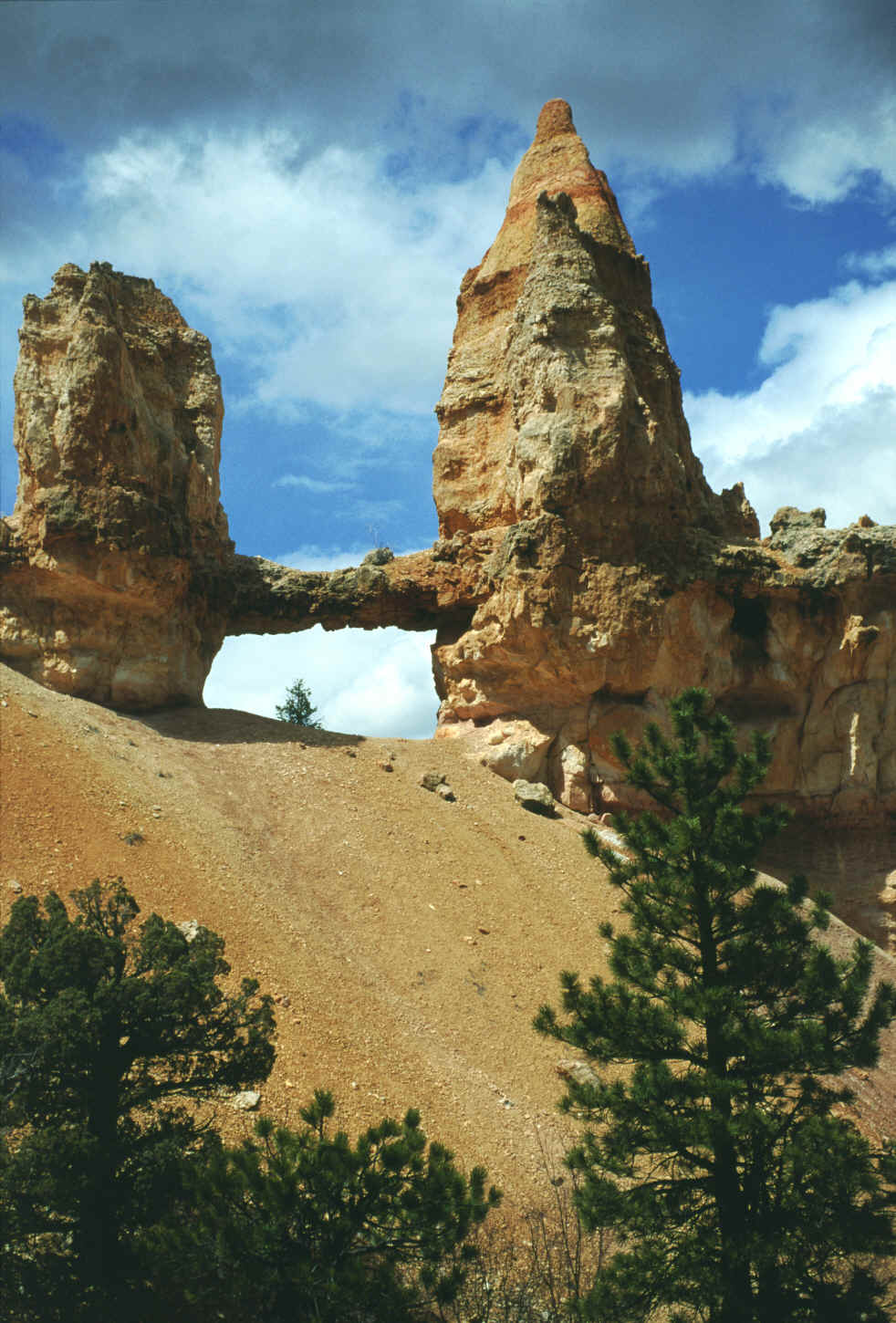
Fairview Arch --
Bryce Canyon
I had no idea this arch existed, I just pulled off the road to look over the
edge of the cliff, and there it was -- one of the few arches you actually look
down on. The scree here is just as bad as at the Tower Bridge, so I have never attempted getting
down to it -- once you started sliding, you'd end up at the bottom, a long way
from your
car still at the top!
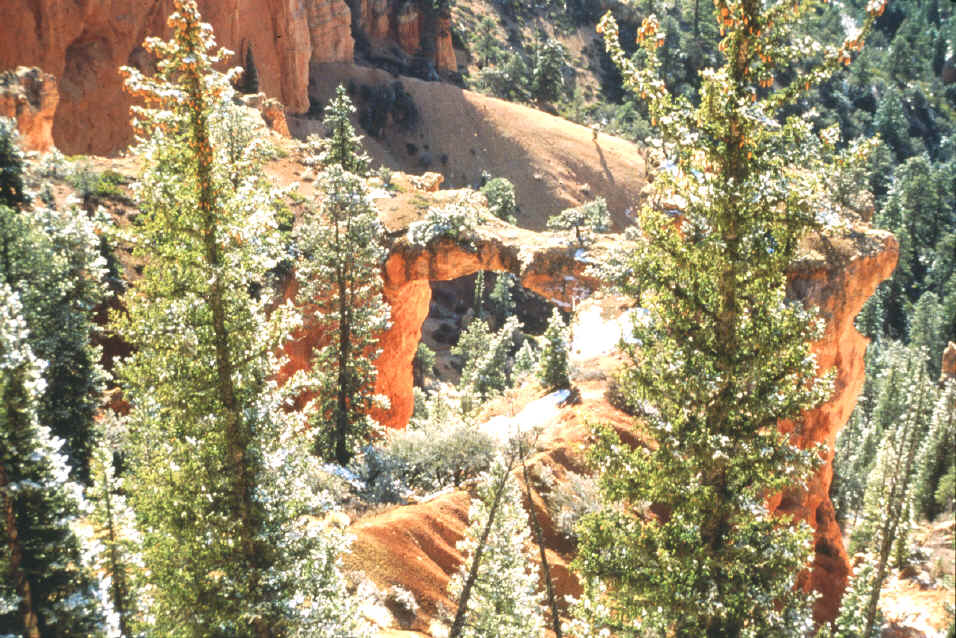
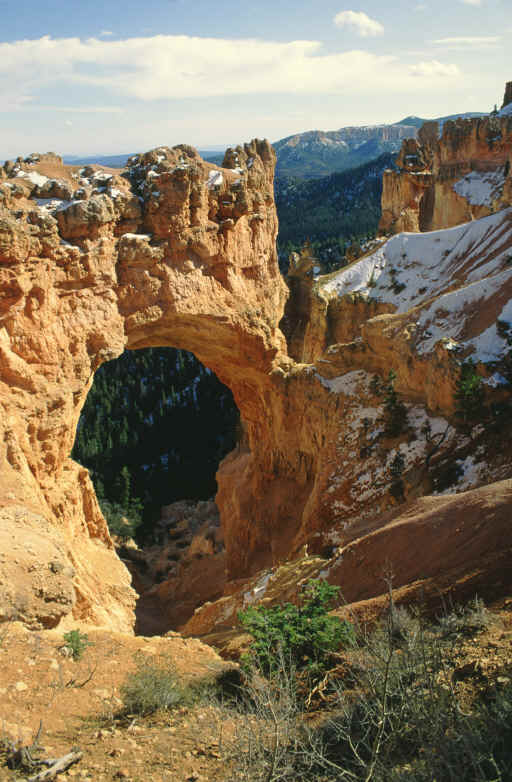
The Bryce Canyon Arch
is the largest in the park, and can easily be seen from the main park
road. It is made of the typical crumbly red rock that the whole canyon is
made from, which erodes more quickly than the solid sandstone found in the
eastern side of Utah; therefore most arches in Bryce Canyon don't get very
large, or if they do, they don't last long -- only a few thousand years, maybe.

The Mossy Cave Windows
are in a different part of Bryce Canyon
from where the main canyon is, and
get few visitors. The term "window"
is often used for small arches like these.
It is obvious that the rock layers above
the windows are harder than the rock
below, so the lower rock erodes faster,
forming the windows.
The Wall of Windows,
Bryce Canyon -- notice backpacker at bottom, for scale. 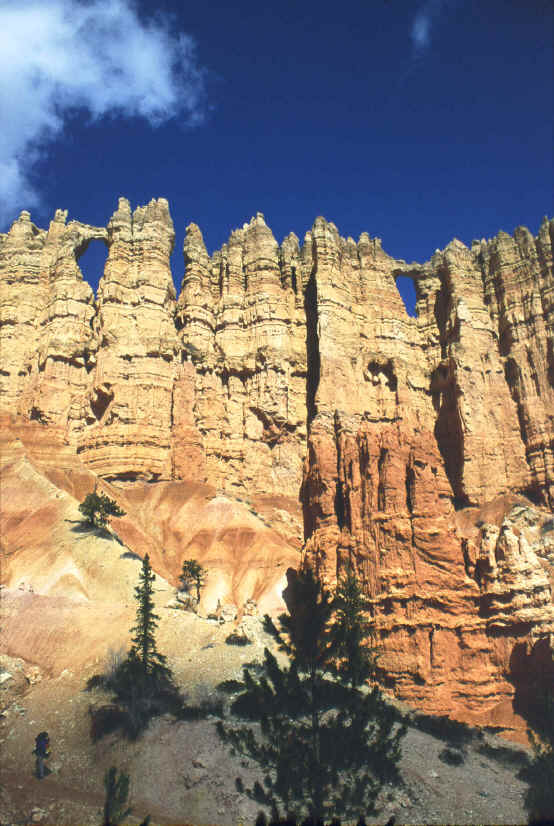
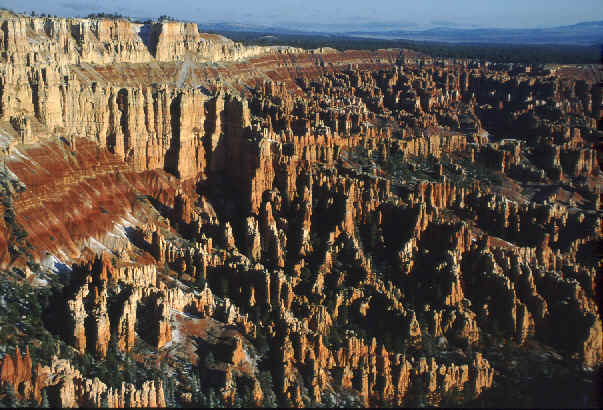
A view of Bryce Canyon and its incredible rock formations... "a hell of a
place to lose a cow," according to old Ebenezer Bryce.
Swasey’s Arch
— San Rafael Swell, central Utah, a few miles from
Castle Dale.
A really remote arch in the western part of the San Rafael Swell. It is a
lot bigger than it looks at first glance, with an opening of 125 ft., making it
quite impressive from within. However, the fin of rock it is in is so
enormous it could easily support a much larger opening. Swasey's Arch has
the potential, perhaps more than any other, to become the world's largest arch,
many eons from now.

Eagle Canyon Arch
-- San Rafael Swell, central Utah
This is a great example of a jughandle arch -- one that is much more vertical than
horizontal.
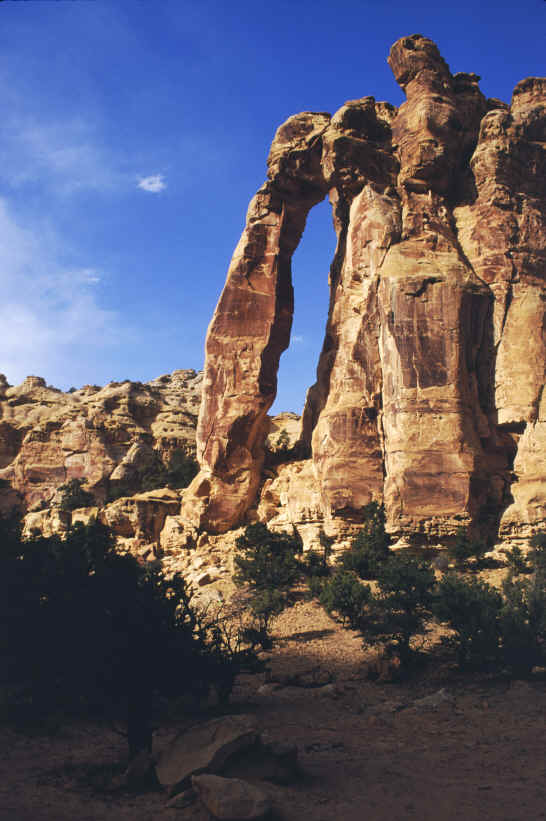

Hurst Arch
Also in the San Rafael Swell area,
this little arch has a perfect classic shape.
The Horizon Arch
in the San Rafael Swell
There are other Horizon Arches, but this is central Utah's version,
seldom seen -- looks like a giant fist punched through a wall.

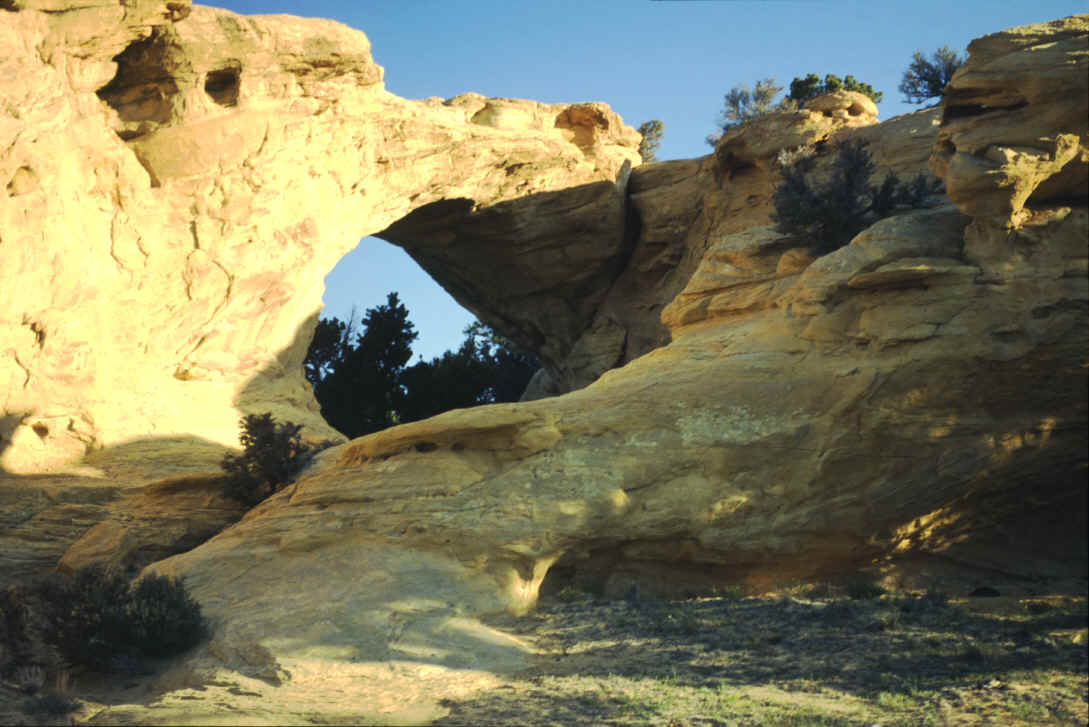
Dutchman's Arch:
This one is also in the San
Rafael Swell area
of central Utah. It's not hard to get to, and
the rock formation it is located in is visible
from the freeway. It is made of a pretty,
yellowish rock. I spent the night in front of it
in order to get this early morning shot.
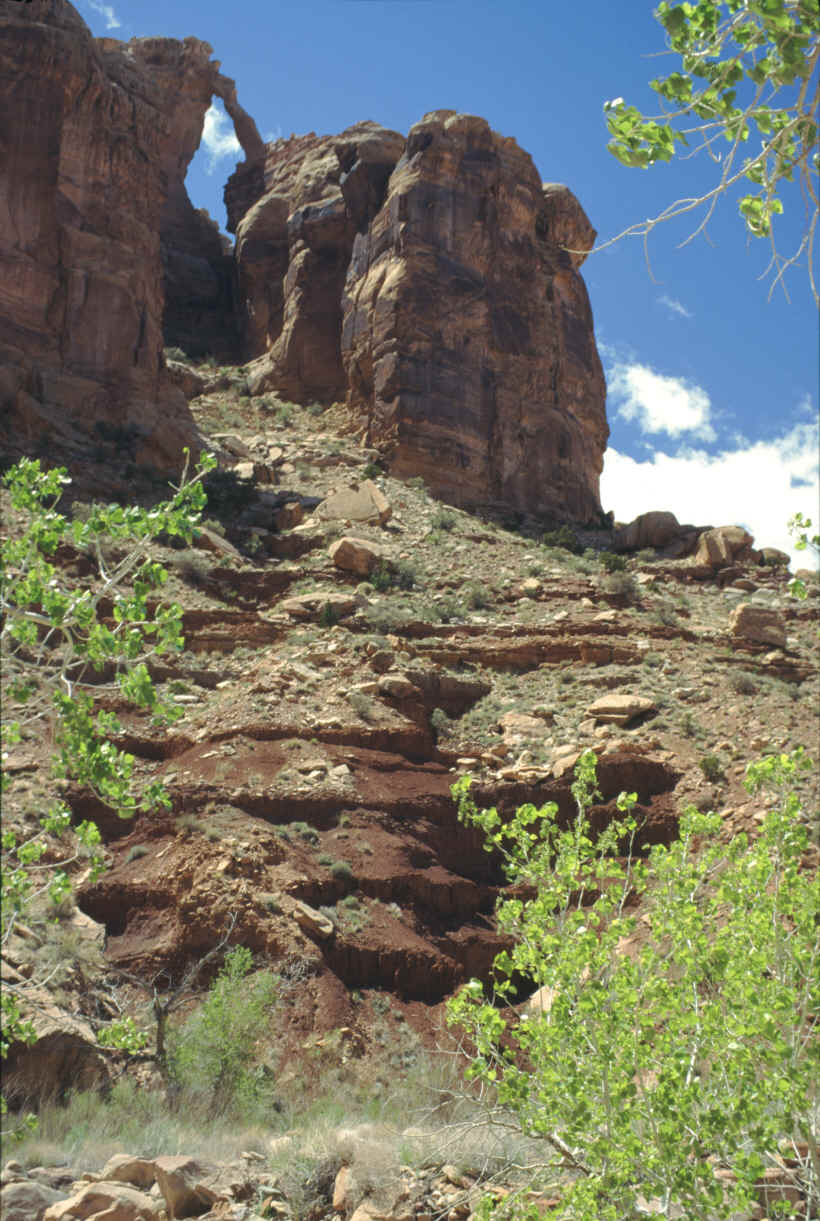
The Delicate Arch of Spring Canyon -- no one is likely to confuse this amazing formation with the world's most famous arch, the Delicate Arch in Arches National Park, even though this one could quite possibly be even more delicate. It takes a long, rough drive and a half-day's backpack to go visit it, and very few do, though it's a wonderful hike. I want to go back, because there is supposedly another similar arch quite a ways farther up Spring Canyon that hardly ever gets any visitors at all -- I've never even seen a picture of it yet.
Mystery Arch:
I went on a group hike with the Natural Arch and Bridge
Society to visit this
strange arch far up in the San Rafael Swell... certainly one of the longest,
toughest day hikes I've done.
In fact we decided the name of the arch should be changed to Misery
Arch.
It's one of those impossible-to-photograph spans, but impressive in real life...
you just have to be there.
Everything there is on an extreme slant. It's large, it's narrow, it's
fragile, and almost utterly unknown;
and very likely to stay that way.

Angel Arch
Two great
arches in Utah are called Angel Arch. The one in Canyonlands is the most
famous,
but this one
got the name first. It is in Arch Canyon, just to the east of Natural
Bridges National Monument.
The large
Cathedral Arch is just a few hundred yards away from the even larger Angel Arch.
To get there,
I had to drive for hours on a terrible 4-wheel-drive track that crossed the same
stream 62 times -- each way.
Somewhere
along the way, I never even knew when, I did $1000 of damage to the side of my
truck.
After
spending the night in the back of the truck, I was greatly annoyed to wake up to
a foggy day --
lousy for
pictures, I thought. But I took some anyway, and this turned out to be one
of my all-time favorites.
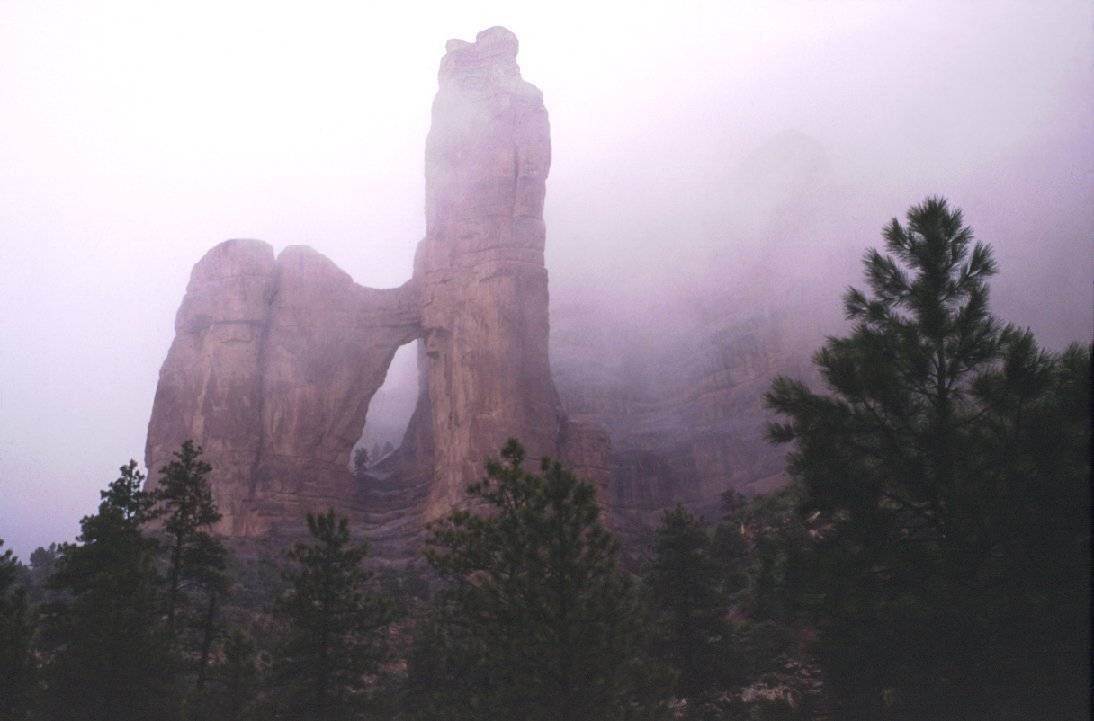
I went back to Arch Canyon in 2009, hoping to drive it again,
but the road is now even worse, and after a mile (and about 9 river crossings) I
could go no farther without probably tearing up my truck. So I parked it,
strapped on a backpack, and hiked the 6 miles in to the arches (on a hot day),
for the pictures below. I should have just stayed near them and camped,
since I had my tent and all; but after the sun went down, I decided for some
reason to hike all the way back out, which was not too smart... I wound up
hiking by flashlight for the last 2 hours! Certainly one of the most
exhausting trips I ever did. You can read the whole story here.

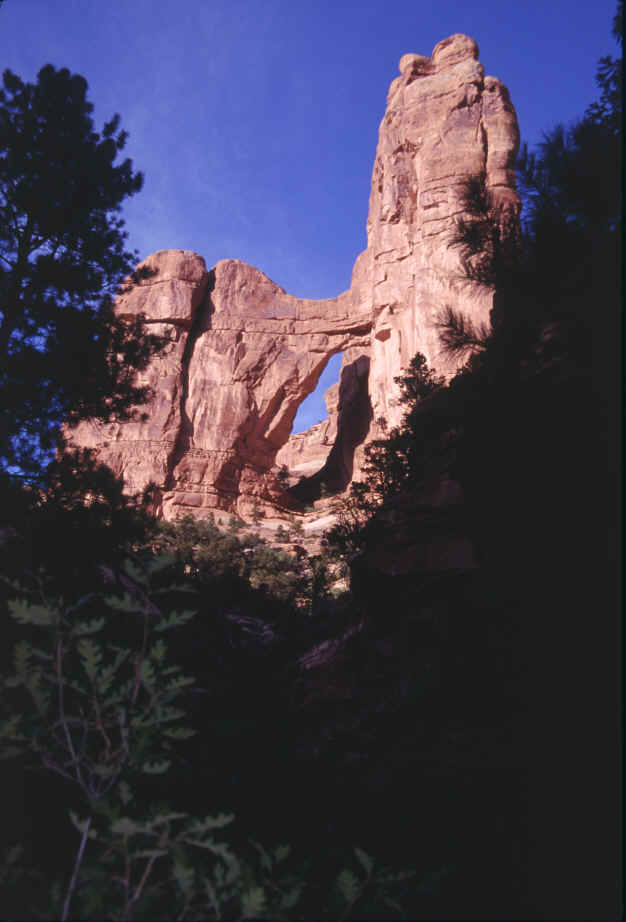
The impressive Cathedral Arch in Arch Canyon would be considered a major arch and definitely worth a major hike to visit if it were located just about anywhere else -- but it is almost within sight of the even grander Angel Arch, and so tends to get somewhat overlooked and overshadowed by its more spectacular neighbor. Also, from the typical viewpoint, no blue sky can be seen through the opening unless you climb right up under it, which is a steep climb. But it is one of the rare arches which faces directly west and often catches the last golden reflections from the setting sun. You would think that more or less one out of four arches would face west, which is true, but very seldom does a great arch catch the last light of day and glow a fiery orange in the sunset light; usually there is a cliff, a wall, a hill, or just a lot of trees across from the arch, which cuts off the light long before the sun gets to the horizon. But directly facing the Cathedral Arch is the wide opening for Texas Canyon, so the evening light is seldom blocked. If you are lucky, you'll get to see a rare, brief, and beautiful show at the end of day, as shown in the second picture below: the wall behind the opening retains the golden light of sunset for several minutes longer than the arch itself.
